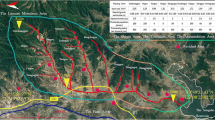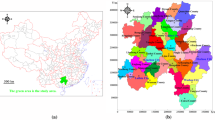Abstract
After a heavy and continuous rainfall from July 27 to 28, 1981, geological disasters involving large debris flow affected the northern part of Wafangdian City and Pulandian City in Dalian, northeast China, and caused considerable loss of life and property. In recent years, precipitation has continued to increase significantly in Dalian, where the largest debris flow gully, named the Dongmatuncun main ditch, is situated. The Dongmatuncun main ditch is 2 km away from the north side of the right bank of the Fudu River in Wanjialing, Wafangdian City. The geomorphological and hydrological conditions, combined with the characteristics of the debris flow solid source, are conducive to debris flow development. Moreover, with an increase in rainfall, debris flow recurrence becomes increasingly likely. We study the debris flow gully in Dongmatun Village by analyzing the formation conditions through field survey. Fuzzy comprehensive evaluation and analytic hierarchy process are used to evaluate the risk of debris flow. Results indicate that the debris flow gully in Dongmatun Village is highly dangerous and debris flow occurs during heavy rainfall. In addition, the breakout of debris flow can threaten human life and property.









Similar content being viewed by others
References
Eldeen MT (1980) Predisaster physical planning: integration of disaster risk analysis into physical planning - a case study in Tunisia. Disasters 4(2):211–222
Gao X, Zhou S-c (2015) Application of fuzzy comprehensive evaluation in debris flow risk assessment. Modern Economic Information 18:40–42
Gómez H, Kavzoglu T (2005) Assessment of shallow landslide susceptibility using artificial neural networks in Jabonosa River Basin, Venezuela. Eng Geol 78(1–2):11–27
Han G, Wang D (1996) Numerical modeling of Anhui debris flow. J Hydraul Eng 122(5):262–265
Hansen A (1984) Landslide hazard analysis. Slope instability. Wiley, New York, pp 523–602
Hollingsworth R, Kovacs GS (1981) Soil slumps and debris flows: prediction and protection. Environ Eng Geosci (1):17–28
Hu X, Huang G (2013) The application of improved efficiency coefficient method in debris flow warning with rock technology in civil engineering: International Conference on Mechanical Engineering, Civil Engineering and Material Engineering (MECEM 2013), Hefei, Peoples R China
Huang LJ (2016) An FAHP-based quantitative method for risk assessment of debris-flow hazards using different fuzzy numbers. International Journal of Erosion Control Engineering 9(2):32–42
Iverson RM (1997) The physics of debris flows. Rev Geophys 35(3):245–296
Jakob DM, Hungr O (2005) Debris-flow hazards and related phenomena. Springer, Berlin
Jian S, Jun R, Xudong F (2016) Assessment on debris flow risk based on fuzzy comprehensive evaluation method. Journal of Catastrophology 2:171–175
Jingshun CPQ (2013) Screening of debris flow risk factors and risk evaluation based on rank correlation. Rock Soil Mech 34(5):1409–1415
Li Y (1999) Problems in assessment of debris flow potentiality. Journal of Mountain Research 17(4):305–311
Li-Feng Y (2008) Debris flow hazard assessment based on SVM. Sci Geogr Sin 02:296–300
Liu XL (1988) Study on the hazard judgment of debris flow. Journal of Catastrophology 03:10–15
Liu Q, Button E, Klima K (2007) Investigation for probabilistic prediction of shear strength properties of clay-rich fault gouge in the Austrian Alps. Eng Geol 94(1–2):103–121
Lo W, Tsao T, Hsu C (2012) Building vulnerability to debris flows in Taiwan: a preliminary study. Nat Hazards 64(3):2107–2128
Rybchenko AA, Kadetova AV, Kozireva EA (2018) Relation between basin morphometric features and dynamic characteristics of debris flows - a case study in Siberia, Russia. J Mt Sci 15(3):618–630
Sup JLS, Sup CCSS, Sup CPS (2012) Potential hazard analysis and risk assessment of debris flow by fuzzy modeling. Nat Hazards
Tiranti D, Cremonini R, Marco F, Gaeta AR, Barbero S (2014) The DEFENSE (debris Flows triggEred by storms - nowcasting system): an early warning system for torrential processes by radar storm tracking using a Geographic Information System (GIS). Comput Geosci 70:96–109
Wang Q, Kong Y, Zhang W et al (2016) Regional debris flow susceptibility analysis based on principal component analysis and self-organizing map: a case study in Southwest China. Arab J Geosci 9(71818)
Yang XM, Liang SY (2008) Application of fuzzy analytic hierarchy process method to debris flow dangerous degree assessment. Journal of Geological Hazards and Environment Preservation 19(2):73–78
Funding
This work was supported by the National Natural Science Foundation of China (No. 41502270), Open Fund of State Key Laboratory of Frozen Soil Engineering (Grant No. SKLFSE201506), and Science and Technology Development Project of Jilin Province, China (20150520076JH).
Author information
Authors and Affiliations
Corresponding author
Rights and permissions
About this article
Cite this article
Shen, S., Liao, W., Nie, L. et al. Debris flow hazard assessment at Dongmatun Village in Laomao mountainous area of Dalian, Northeast China. Arab J Geosci 11, 648 (2018). https://doi.org/10.1007/s12517-018-3953-0
Received:
Accepted:
Published:
DOI: https://doi.org/10.1007/s12517-018-3953-0




